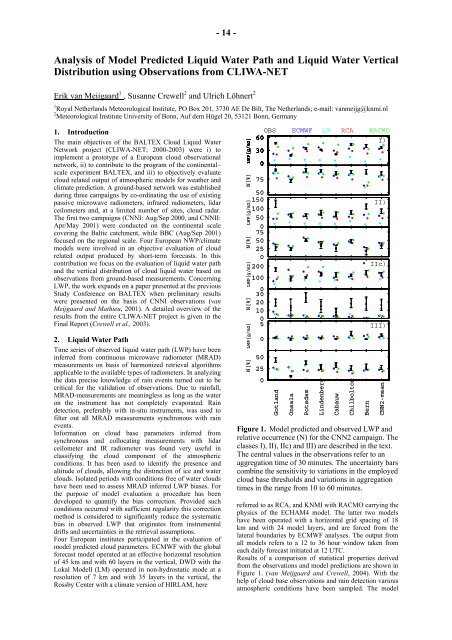Fourth Study Conference on BALTEX Scala Cinema Gudhjem
Fourth Study Conference on BALTEX Scala Cinema Gudhjem
Fourth Study Conference on BALTEX Scala Cinema Gudhjem
You also want an ePaper? Increase the reach of your titles
YUMPU automatically turns print PDFs into web optimized ePapers that Google loves.
-14-<br />
Analysis of Model Predicted Liquid Water Path and Liquid Water Vertical<br />
Distributi<strong>on</strong> using Observati<strong>on</strong>s from CLIWA-NET<br />
Erik van Meijgaard 1 , Susanne Crewell 2 and Ulrich Löhnert 2<br />
1 Royal Netherlands Meteorological Institute, PO Box 201, 3730 AE De Bilt, The Netherlands; e-mail: vanmeijg@knmi.nl<br />
2 Meteorological Institute University of B<strong>on</strong>n, Auf dem Hügel 20, 53121 B<strong>on</strong>n, Germany<br />
1. Introducti<strong>on</strong><br />
The main objectives of the <strong>BALTEX</strong> Cloud Liquid Water<br />
Network project (CLIWA-NET; 2000-2003) were i) to<br />
implement a prototype of a European cloud observati<strong>on</strong>al<br />
network, ii) to c<strong>on</strong>tribute to the program of the c<strong>on</strong>tinental–<br />
scale experiment <strong>BALTEX</strong>, and iii) to objectively evaluate<br />
cloud related output of atmospheric models for weather and<br />
climate predicti<strong>on</strong>. A ground-based network was established<br />
during three campaigns by co-ordinating the use of existing<br />
passive microwave radiometers, infrared radiometers, lidar<br />
ceilometers and, at a limited number of sites, cloud radar.<br />
The first two campaigns (CNNI: Aug/Sep 2000, and CNNII:<br />
Apr/May 2001) were c<strong>on</strong>ducted <strong>on</strong> the c<strong>on</strong>tinental scale<br />
covering the Baltic catchment, while BBC (Aug/Sep 2001)<br />
focused <strong>on</strong> the regi<strong>on</strong>al scale. Four European NWP/climate<br />
models were involved in an objective evaluati<strong>on</strong> of cloud<br />
related output produced by short-term forecasts. In this<br />
c<strong>on</strong>tributi<strong>on</strong> we focus <strong>on</strong> the evaluati<strong>on</strong> of liquid water path<br />
and the vertical distributi<strong>on</strong> of cloud liquid water based <strong>on</strong><br />
observati<strong>on</strong>s from ground-based measurements. C<strong>on</strong>cerning<br />
LWP, the work expands <strong>on</strong> a paper presented at the previous<br />
<str<strong>on</strong>g>Study</str<strong>on</strong>g> <str<strong>on</strong>g>C<strong>on</strong>ference</str<strong>on</strong>g> <strong>on</strong> <strong>BALTEX</strong> when preliminary results<br />
were presented <strong>on</strong> the basis of CNNI observati<strong>on</strong>s (van<br />
Meijgaard and Mathieu, 2001). A detailed overview of the<br />
results from the entire CLIWA-NET project is given in the<br />
Final Report (Crewell et al., 2003).<br />
2. Liquid Water Path<br />
Time series of observed liquid water path (LWP) have been<br />
inferred from c<strong>on</strong>tinuous microwave radiometer (MRAD)<br />
measurements <strong>on</strong> basis of harm<strong>on</strong>ized retrieval algorithms<br />
applicable to the available types of radiometers. In analyzing<br />
the data precise knowledge of rain events turned out to be<br />
critical for the validati<strong>on</strong> of observati<strong>on</strong>s. Due to rainfall,<br />
MRAD-measurements are meaningless as l<strong>on</strong>g as the water<br />
<strong>on</strong> the instrument has not completely evaporated. Rain<br />
detecti<strong>on</strong>, preferably with in-situ instruments, was used to<br />
filter out all MRAD measurements synchr<strong>on</strong>ous with rain<br />
events.<br />
Informati<strong>on</strong> <strong>on</strong> cloud base parameters inferred from<br />
synchr<strong>on</strong>ous and collocating measurements with lidar<br />
ceilometer and IR radiometer was found very useful in<br />
classifying the cloud comp<strong>on</strong>ent of the atmospheric<br />
c<strong>on</strong>diti<strong>on</strong>s. It has been used to identify the presence and<br />
altitude of clouds, allowing the distincti<strong>on</strong> of ice and water<br />
clouds. Isolated periods with c<strong>on</strong>diti<strong>on</strong>s free of water clouds<br />
have been used to assess MRAD inferred LWP biases. For<br />
the purpose of model evaluati<strong>on</strong> a procedure has been<br />
developed to quantify the bias correcti<strong>on</strong>. Provided such<br />
c<strong>on</strong>diti<strong>on</strong>s occurred with sufficient regularity this correcti<strong>on</strong><br />
method is c<strong>on</strong>sidered to significantly reduce the systematic<br />
bias in observed LWP that originates from instrumental<br />
drifts and uncertainties in the retrieval assumpti<strong>on</strong>s.<br />
Four European institutes participated in the evaluati<strong>on</strong> of<br />
model predicted cloud parameters. ECMWF with the global<br />
forecast model operated at an effective horiz<strong>on</strong>tal resoluti<strong>on</strong><br />
of 45 km and with 60 layers in the vertical, DWD with the<br />
Lokal Modell (LM) operated in n<strong>on</strong>-hydrostatic mode at a<br />
resoluti<strong>on</strong> of 7 km and with 35 layers in the vertical, the<br />
Rossby Center with a climate versi<strong>on</strong> of HIRLAM, here<br />
0<br />
N[%] LWP[g/m2]<br />
0<br />
N[%] LWP[g/m2]<br />
0<br />
N[%] LWP[g/m2]<br />
LWP[g/m2]<br />
N[%]<br />
OBS<br />
60<br />
30<br />
0<br />
75<br />
50<br />
150<br />
100<br />
50<br />
0<br />
75<br />
50<br />
25<br />
0<br />
200<br />
100<br />
0<br />
30<br />
20<br />
10<br />
0<br />
5<br />
0<br />
50<br />
25<br />
0<br />
Gotland<br />
Onsala<br />
ECMWF<br />
Potsdam<br />
Lindenberg<br />
LM<br />
Cabauw<br />
RCA<br />
Chilbolt<strong>on</strong><br />
Bern<br />
RACMO<br />
I)<br />
II)<br />
IIc)<br />
III)<br />
CNN2-mean<br />
Figure 1. Model predicted and observed LWP and<br />
relative occurrence (N) for the CNN2 campaign. The<br />
classes I), II), IIc) and III) are described in the text.<br />
The central values in the observati<strong>on</strong>s refer to an<br />
aggregati<strong>on</strong> time of 30 minutes. The uncertainty bars<br />
combine the sensitivity to variati<strong>on</strong>s in the employed<br />
cloud base thresholds and variati<strong>on</strong>s in aggregati<strong>on</strong><br />
times in the range from 10 to 60 minutes.<br />
referred to as RCA, and KNMI with RACMO carrying the<br />
physics of the ECHAM4 model. The latter two models<br />
have been operated with a horiz<strong>on</strong>tal grid spacing of 18<br />
km and with 24 model layers, and are forced from the<br />
lateral boundaries by ECMWF analyses. The output from<br />
all models refers to a 12 to 36 hour window taken from<br />
each daily forecast initiated at 12 UTC.<br />
Results of a comparis<strong>on</strong> of statistical properties derived<br />
from the observati<strong>on</strong>s and model predicti<strong>on</strong>s are shown in<br />
Figure 1. (van Meijgaard and Crewell, 2004). With the<br />
help of cloud base observati<strong>on</strong>s and rain detecti<strong>on</strong> various<br />
atmospheric c<strong>on</strong>diti<strong>on</strong>s have been sampled. The model













